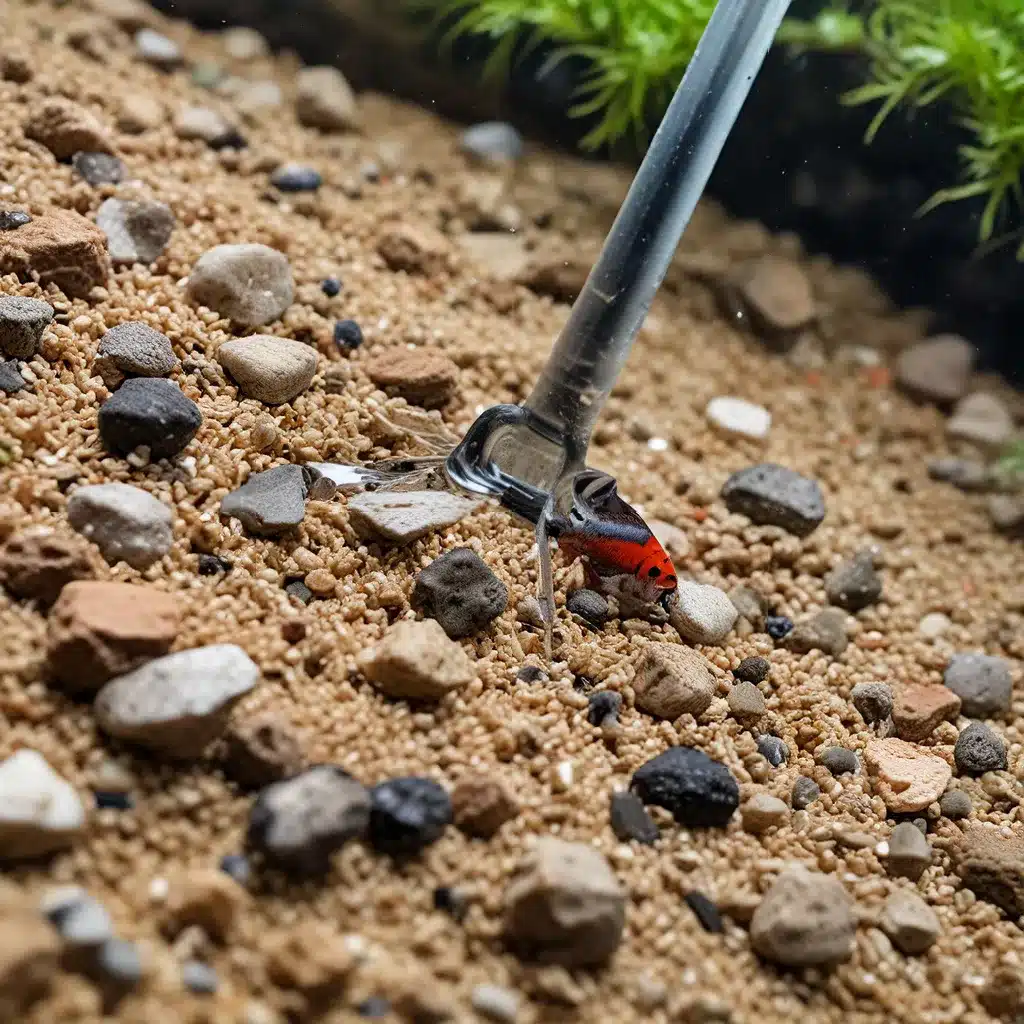
The Importance of Proper Gravel Maintenance
One of the most fundamental yet often overlooked aspects of aquarium care is the regular maintenance of your gravel substrate. While it may not be the most exciting task, proper gravel cleaning and siphoning is essential for maintaining a healthy, thriving ecosystem in your aquarium.
The gravel bed in your tank serves as a vital habitat for beneficial bacteria, providing a vast surface area for the nitrogen cycle to take place. However, over time, this substrate can become clogged with accumulated debris, uneaten food, and waste products from your fish. If left unchecked, this buildup can lead to a variety of issues, including poor water quality, increased algae growth, and even the development of anaerobic pockets that can be detrimental to your aquatic life.
Mastering the Art of Aquarium Siphoning
Effective gravel cleaning through siphoning is a skill that every aquarium enthusiast should strive to perfect. By following a few key techniques and best practices, you can ensure that your gravel remains clean, your water quality remains pristine, and your fish thrive in a healthy environment.
Choosing the Right Siphon:
The first step in mastering aquarium siphoning is selecting the appropriate tool for the job. There are a variety of siphon designs available, each with their own unique features and benefits. When choosing a siphon, consider factors such as the size of your aquarium, the depth of your gravel bed, and the type of debris you typically encounter. Some popular siphon options include:
- Gravel Vacuums: These specialized siphons are designed with a wide, flat nozzle that allows for efficient removal of debris from deep within the gravel.
- Python No-Spill Clean and Fill: This versatile system combines a siphon with a water supply hose, allowing you to both clean and refill your aquarium with ease.
- Handheld Siphons: Compact and maneuverable, these siphons are well-suited for smaller aquariums or hard-to-reach areas.
Proper Siphoning Technique:
Once you’ve selected your siphon, it’s time to put it to use. Begin by thoroughly cleaning the gravel, using a gentle, sweeping motion to dislodge and remove accumulated debris. Be careful not to disturb the gravel too vigorously, as this can stir up sediment and cloud your water.
When siphoning, maintain a steady, even suction to avoid creating a vortex that could disrupt your aquarium’s inhabitants. Additionally, be mindful of the water level in your tank, as removing too much water at once can cause stress for your fish. It’s generally recommended to perform partial water changes of 25-50% during each siphoning session.
Maintaining Your Siphon:
To ensure the longevity and effectiveness of your siphon, it’s essential to keep it clean and well-maintained. After each use, thoroughly rinse the siphon with freshwater to remove any debris, and allow it to air dry completely before storing. Additionally, regularly inspecting the siphon for any cracks or wear and tear can help prevent leaks or malfunctions during use.
Incorporating Botanical Materials for Enhanced Gravel Maintenance
For aquarium enthusiasts who have embraced the botanical method, incorporating natural materials such as leaves, twigs, and seed pods can provide an added layer of functionality to your gravel maintenance routine.
These botanical elements can help to create a more dynamic and self-sustaining ecosystem within your aquarium. As the organic materials decompose, they release valuable nutrients and tannins that can be readily absorbed by your plants and beneficial bacteria. This, in turn, can help to reduce the buildup of waste and debris in your gravel, minimizing the frequency and intensity of your siphoning efforts.
Furthermore, the presence of these botanical materials can encourage the growth of diverse microbial communities, including fungal species and biofilms, which can play a crucial role in processing and breaking down organic matter within the gravel bed. By embracing this natural approach, you can create a more balanced and self-regulating aquarium, reducing the need for constant maintenance and intervention.
Embracing the Ephemeral Nature of Botanical Aquascapes
One of the key aspects of the botanical method is the acceptance and appreciation of the ephemeral nature of these natural materials. Unlike traditional aquascaping, where the goal is often to maintain a static, perfectly manicured appearance, the botanical approach acknowledges and celebrates the dynamic, ever-changing nature of the aquarium ecosystem.
As the leaves, twigs, and seed pods slowly break down and decompose over time, they will naturally alter the visual appearance of your aquarium. This process, while not always aesthetically pleasing in the short term, is an integral part of the overall functionality and health of your aquatic environment.
By embracing this natural cycle of growth, decay, and renewal, you can foster a deeper understanding and appreciation for the delicate balance that exists within your aquarium. This mindset shift can also help to alleviate the temptation to constantly intervene and “fix” perceived issues, allowing your aquarium to find its own natural equilibrium.
Conclusion: Reaping the Rewards of Diligent Gravel Maintenance
Proper gravel maintenance through effective siphoning techniques is a fundamental aspect of aquarium care that should not be overlooked. By regularly removing accumulated debris and waste from your substrate, you can ensure that your aquarium’s water quality remains high, your fish stay healthy, and your plants thrive.
For those who have embraced the botanical method, incorporating natural materials into your aquarium can provide an added layer of functionality and self-regulation to your gravel maintenance routine. By understanding and accepting the ephemeral nature of these botanical elements, you can cultivate a deeper appreciation for the dynamic ecosystem within your aquarium, ultimately leading to a more rewarding and satisfying hobby experience.
Remember, the key to successful aquarium siphoning and gravel maintenance lies in consistency, attention to detail, and a willingness to adapt to the ever-changing needs of your aquatic environment. By mastering these techniques and embracing the natural processes at work in your tank, you’ll be well on your way to unlocking the secrets of a thriving, vibrant aquarium.

